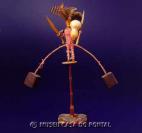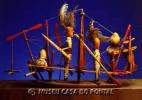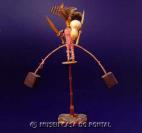NEARBY LOCATIONS
LOCAL ARTISTS
WORKED THEMES
Aguas Belas - PE
The municipality is located in the semi-arid region [Agreste] of Pernambuco and around 300km from the capital. Aguas Belas has a population estimated at 40,511, and access to the municipality is by the federal highway BR-423 (IBGE, CNM, 2011). The region of Aguas Belas today was inhabited originally by indigenous groups. The first attempt to catechise the natives dates from the beginning of the 18th century, and the district was created jointly with the first parish in 1766. The name given since then was coined by a magistrate who had found clean drinking water in a region considered arid (IBGE, 2011). It should be mentioned that the area of Aguas Belas was originally under the domain of the Fulni-ô Indians, known since the 18th century. With a current population of approximately 3,300 Indians, the Fulni-ô occupy an area divided into 427 individual lots, covering a total area of 11,505ha (UFPE). Nhô Caboclo, as Manuel Fontoura was known, was born in the village of the Fulni-ô. He was never sure of his year of birth but it dates from the first decade of the 20th century. He was mestizo and vague about his origins, did not consider himself Indian, but “caboclinho” [a little bit native], as Coimbra et al (2010) recount. He was brought up in the countryside on a farm in Garanhauns (PE), and since childhood Nhô Caboclo would make objects from clay and materials common in the region, such as small-leafed bent grass and manioc. When adult, he moved to the capital Recife, where he began his artistic life working with clay. However, most of his production was based on wood and tinplate (Frota, 2005; Mascelani, 2006). His work instruments would be his own tools, almost all created by the artist himself. In his work, Nhô Caboclo would show concern with the “structures of order and disorder, man’s submission, violence and prowess” (Frota, 2005: 325). He explored marine themes and invented new thematic lines, with emphasis on rachos and torés. Another feature of his work is the intense use of black and red colour, and birds’ feathers. His works are found in the collection of a number of Brazilian museums and major private collections. This remarkable artist died in 1976 (Frota, 2005; Mascelani, 2006).



